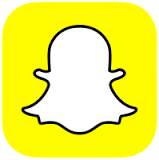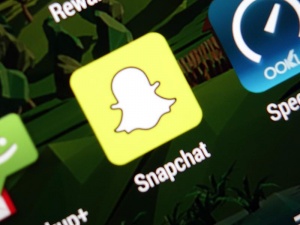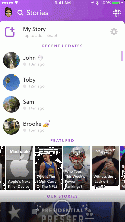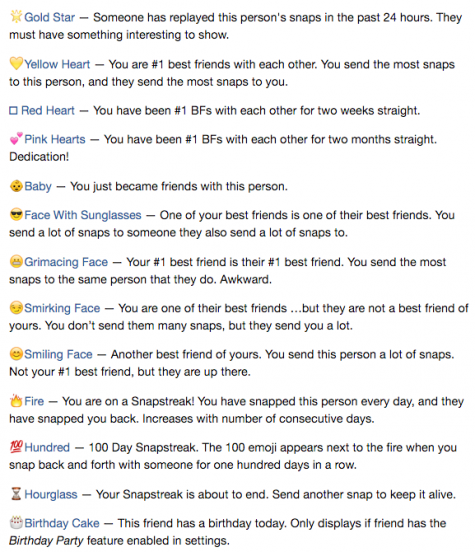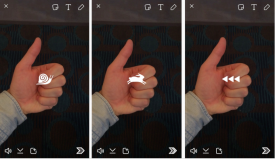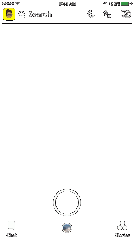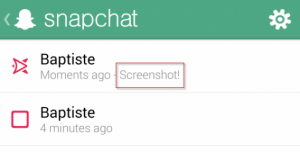Snapchat
|
Snapchat is a social-networking mobile application created by Snap Inc. that allows users to send short-lived photos and videos to their friends. Users can add different filters, effects, captions, and drawings to pictures and videos they record. These creations are called 'snaps' and can last for a maximum of 20 seconds. Both photos and videos disappear forever unless the receiver of the snap takes a screenshot of the snap, notifying both users. Content placed on a user's Snapchat Story - a compiled feed of photos and videos viewable to a user's friends - stays in place for 24 hours. The app provides a variety of other features including: messaging and video calling, viewing content feeds created by brands or networks, sending money to friends, and identifying music based on what's currently playing. Snapchat has become one of the most popular social networking platforms among millennials. Ethical concerns with Snapchat revolve around issues such as privacy, cat-fishing, sexting, and security. In particular, users are intuitively misled by Snapchat to believe that their photos disappear after their expiration when, in fact, posts are actually stored somewhere by the firm. Furthermore, some users claim that Snapchat is illegally storing their sensitive identity features, such as iris scans, fingerprints and face geometrics. This fact, coupled with one's knowledge of the previous security breaches at Snapchat are a source of ethical concerns for many users. Yet, the most common concern about Snapchat is still the platform's widely-perceived enabling of "sext-ing," as many observers and surveys have confirmed that the "disappearing" message service is commonly utilized for the virtual exchange explicit images.
Contents
- 1 History
- 2 Features
- 3 Ethical Concerns
- 4 See Also
- 5 References
History
Early Years
Reggie Brown and Evan Spiegel are the co-creators of Snapchat. They met during their freshman year at Stanford University when they joined the same fraternity, Kappa Sigma. In Kappa Sigma, Spiegel and Brown met fellow co-founder and future programmer of the app, Bobby Murphy. Brown and Spiegel launched an app called Picaboo in July of 2011. Brown sparked the idea for the app when he said, "I wish these photos I am sending this girl would disappear."[1] In April of 2011, Spiegel presented his idea to his class as a final project and his fellow classmates were hesitant about the app's success. Murphy eventually wrote the source code and Picaboo launched as an iOS app in July 2011. It was launched from Speigel's living room. Two months later, the company switched its name to Snapchat, with Spiegel as CEO, Bobby Murphy as CTO, and Reggie Brown as CMO.[2] Brown left his two partners at the end of 2011 due to financial disagreements. At first, the application grew slowly in popularity, but eventually, it's popularity picked up among high school students. By April 2012, the application had over 100,000 users. Spiegel dropped out of Stanford in his last year when Snapchat began generating high profits. Snapchat Inc., a Delaware corporation was created in 2012.[3]
Expansion
In April 2012, Lightspeed Venture Partners invested $485,000 into Snapchat. This was the first big investment that Snapchat received. By winter of 2012, the app launched on Android phones. Snapchat also introduced the video-sending feature. By February of that year, over 60 million snaps were being sent per day.
By May of 2013, 150 million snaps were being sent per day. With Snapchat's growing popularity and success, Mark Zuckerberg offered to buy Snapchat for $3 billion in November of 2013, but Snapchat declined. Later Snapchat co-founder Evan Spiegel stated that the reason he turned down Zuckerberg’s accusation offer was that "few people in the world who get to build a business like this, I think trading that for some short-term gain isn’t very interesting.”[4]
Despite the app's growing success, there was an ongoing lawsuit between the original founders over who truly came up with the idea for the app. After years of battling it out in court, the lawsuit was finally settled between the founders in 2014. Spiegel and Murphy paid Reggie Brown an undisclosed amount to end the tumultuous lawsuit.
By May of 2015, Snapchat was valued at approximately $16 billion.[5] After introducing wearable sunglasses called Snapchat Spectacles in 2016, the company rebranded to the name Snap Inc.[6]
Initial Public Offering
On March 2, 2017, Snap Inc. became a publicly traded company, with its "flagship" product being Snapchat[3]. Snap Inc.'s shares starting trading at $24 a share which was up over 40% from the $17 per share price set by the company for its price offering.[7] According to the Snap Inc. S-1, even after the public offering, the two co-founders control all decisions because they control a substantial majority of the company's voting stock.[3] The stock offered in the public offering has no voting rights.[3]
Features
When Snapchat was initially launched, users were only able to send pictures to each other. Since then, Snapchat has introduced a myriad of new features.
Snapchat Videos
In December of 2012 Snapchat introduced the video feature. In this feature, users capture short videos that they can then send to their Friends via Snapchat. These videos can last up to 20 seconds and cannot be re-watched, as they expire immediately after they are watched.
Snapchat Story
In October of 2013, Snapchat introduced the story feature. Previously, the only people that could see your snaps were other users that you individually sent snaps to. The My Story feature allows users to post a snap of a photo or video that everyone on their list of Snapchat friends can see. It is automatically deleted after 24 hours, but unlike individual snaps, it can be watched many times. There is also a way to see who watched your snap story or took a screenshot of it.
In June of 2014, the 'Our Story' feature was released. Users could now post their snaps to a single-event based story that all Snapchat users could see. The 'Our Story' featured different cities, sporting events, fashion shows, holidays, major world events and more. Snapchat was no longer just a way to communicate with friends but also offered a way to stay updated with different cultural and world events through people's personal selfies, pictures, and videos.
Instant Messaging and Video Calling
In May of 2015, Snapchat introduced an instant messaging and video calling feature. Users can respond to a snap by messaging back the sender or send a short video. Users can also video call each other if they are both on the app at the same time. This can be done by clicking click the box button in the left bottom corner to access your snaps, then swiping right on a particular person's name. This is where the user can choose from the different modes of messaging.
Trophy Case
In Snapchat's major update in September 2015, they debuted the Trophy Case. This case unlocks trophies for reaching a certain milestone on Snapchat from hitting a certain number of points to sending your first video snap.[8] Users can access their trophy case by hitting the white ghost in the top center of the landing page and hitting the trophy symbol that is in the same spot. There the trophies appear. If the user has earned a trophy, the emoji is displayed. If the user has not hit the milestone, a lock emoji is seen, followed by a question mark if clicked. This makes it difficult for users to attain the trophies as there is no way to know how to earn them. Snapchat stated that there is no public list of the trophies, but users can learn as they go. But, there is speculation of what is needed to acquire certain trophies, one such list can be found here.
Friends List Emojis
In September 2015 Snapchat introduced the friends list emojis. These emojis show up next to a friend's name over time for several different reasons. They are private and only can be seen by the user. These reasons, along with their corresponding default emoji, are listed to the right. Users have the ability to customize the emojis displayed in their friends list.
Other emojis appear on Snapchat as well. These custom emojis are in a person's name and represent an official, verified account.[9]
Snapstreaks
A Snapstreak tells a user how many consecutive days they've chatted with someone on Snapchat. If that person does not reply to one's Snap within 24 hours, the Snapstreak is broken. This has become an increasingly popular way for teens to "quantify" their relationships. Originally intended to keep users engaged, it has turned into a serious source of stress for teens. Some professionals are criticizing this feature of Snapchat, calling it an unethical design of the app. It "exploits psychological vulnerabilities to influence what users do without realizing it," according to former Google design ethicist, Tristan Harris.[10] This feature, along with a person's Snapchat score (total number of Snaps sent), quantifies each user's use of the app into a single number. To some, Snapstreaks are meaningless internet points that they gather for talking to their friends. But for many teens these days, it's how a friendship and, more importantly, their social status is defined.
Bitmojis
Alongside emojis, users can download the Bitmoji app to create a personalized avatar to be more expressive in Snapchat. After downloading the app, users can personalize the Bitmoji by choosing face shape, hair color and texture, and outfits that most closely resemble their own appearance and personality. Then the user can link the Bitmoji app to snapchat and much like the emoji keyboard, a Bitmoji gallery will appear in the users snapchat alongside the regular emoji options. There are hundreds of Bitmojis which can be used for any experience, situation, or feeling that the user might want to express. For example, there are several Bitmojis for expressions such as "Good Morning", "Good night", romantic expressions such as "Thinking of you", "Miss you", "I love you", and popular pop culture expressions as well such as "New phone who dis", and "Cash me outside". The Bitmojis change regularly to adapt to the changing cultural environment, however some staple Bitmojis always stay in place. Due to the amount of Bitmojis available, users are able to tailor their messages to their audience and make their snapchats more relatable, funny, or adapt their snapchats to whichever emotion they are feeling.[11]
Groups
In addition to the ability to privately snap friends, Snapchat rolled out the Groups feature in late December.[12] This group chat feature has a cap of 16 users, and all the same rules of a regular snap conversation apply: the group chats automatically delete after 24 hours, and snaps can only be opened once and/or replayed once by each group member.[13] If a user taps to save a message, that message is saved within the group chat, available for all members to view. Similar to tapping another user's name on one's friends list, users can also tap any other user's name within the group chat to be redirected to a private conversation between the two. If a user chooses to leave the Group, all messages produced by them will be cleared from the chat, regardless of if they had been saved.
Filters and Effects
Original Filters and Effects
In December of 2013, Snapchat introduced timestamps, temperature, speed overlays, and color filters. After users takes a picture, they can view the different options by swiping left or right on the screen. Snapchat also allows users to draw free-hand on their pictures using the touch of their finger. The user can pick any color they wish and add illustrations to their already taken pictures.
Lenses
In September of 2015 Snapchat introduced different lenses for selfies.[14] These features came after Snapchat acquired the Ukrainian startup Looksery in September 2015, which specializes in adding live animated effects to videos.[15] This was the power behind Snapchat lenses, which let you choose a face filter to animate your selfies.[16] Some lenses are obvious right away, while others require the user to perform an action, such as opening their mouth or raising their eyebrows. In order to use the lenses, the front camera must be enabled. The user must then press and hold their face on the screen until the lenses appear along the bottom. The user can then slide through the different lenses and choose to use one as they wish. Popular filters include the 'puppy-dog filter' or 'flower crown filter'. Snapchat provides up to ten options to choose from, updating almost every day in accordance with holidays or events occurring nearby. Originally, Snapchat offered users the ability to purchase their favorite lenses for $0.99, but they recently scrapped that idea. Instead, they now update the lenses on a daily basis, replacing the oldest lens with a new one everyday.[15] But if users previously bought lenses, they will be permanently available.
Speed Modifiers
In October 2016, Snapchat introduced a new set of filters called "Speed Modifiers" for videos.[15] These filters include slow motion, fast forward, or rewind effects. To use these filters, a user must first shoot a video on Snapchat and then swipe until the filters appear.
Geofilters
Geofilters are visual overlays only available at certain locations.[17] Major cities and landmarks are most likely to utilize the Geofilter feature, but users may submit their own images as filters (though Snapchat must approve them first.) Companies can also sponsor Geofilters for promotion, which has become a major source of revenue for Snapchat. In addition to companies sponsoring Geofilters, regular Snapchat users can also purchase customized Geofilters for events such as birthdays, anniversaries, weddings, or any other special occasion which the user wants the surrounding area or attendees to know about. These "on-demand" Geofilters can be entirely designed by the user or the user can choose a preexisting template offered by Snapchat. Next, the user can specify the area within which the filter can be used. Finally, the user can submit it for review and purchase it to be used for a short period of time. Snapchat charges $5 for every 20,000 square feet of space within which the filter can be applied.
Snapcash
In November of 2014, Snapchat partnered with Square Cash to launch the Snapcash feature in which users can send money to their friends on the app. Snapchat users can add a debit card or bank account, type a dollar amount into Snapchat's text-chat feature, and hit the green pay button to instantly send a friend money.[18] All of the user's account details are held by Square Cash, rather than Snapchat, so users don't have to worry about trusting Snapchat with personal information. In the past, Snapchat has had issues with privacy and security.
Usage at Michigan
Snapchat is widely popular among University of Michigan students, and the University was one of the first institutions to create an official Snapchat account. The following was gathered from a survey about Michigan students' Snapchatting habits:
- 43% use Snapchat to flirt
- 86% send Snapchats to friends at Michigan
- 90% send Snapchats to friends at other schools
- 77% mostly send "selfies" on Snapchat
- 16% mostly send Snapchats that are not of themselves
- 67% make ugly faces in Snapchats
- 18% avoid making unattractive faces in snapchats
- 46% only send Snapchats to their close friends
- 20% use the Snapchat Stories feature
- 59% send Snapchats when they go out at night
- 83% send Snapchats during the school day
- 61% send Snapchats during class[19]
Snapchat Discover
In January of 2015, Snapchat introduced the Discover feature. Discover allows users to view content from different brands or networks such as CNN, The Wall Street Journal, Entertainment Weekly, Buzzfeed, the Food Network, DailyMail, ESPN, IGN, and more. Content ranges from interactive stories to Top Ten lists and is updated every 24 hours by editorial teams. When viewing a Discover channel's story, users can also swipe up from the bottom to read longform content or view longer videos by the channel.
According to Snapchat's release message explaining the new feature, Discover is a way for brands editors and artists to "build a storytelling format that puts the narrative first."[20] Users can choose what Discover channels' stories they want to view, and have the option to subscribe to any of the channels free of charge. The release is Snapchat's step from one-to-one messages to a more community-based environment.
Snapchat bases their fees for Discover channels on the number of views that a Discover channel obtains. In March 2015, Snapchat charged Discover partners $100 per thousand views.[21]
In addition, Snapchat uses full-screen vertical photo or video advertisements to bring in revenue. Users see these ads when tapping through their friends' Snapchat Stories or watching Discover channels. Restrictions for the content of the ads are stated on Snapchat's advertising policy in addition to reminders about the demographics of the user-base such as age, which ranges from 13 to 99 years.[22]
Memories
The Memories feature on Snapchat is essentially a cumulative archive of the Snaps and Stories users save and upload. It acts as a backup for each user's account. One of the main benefits of Memories is the ability for users to re-share old Snaps and Stories. They can be sent individually to friends or uploaded to one's Story[23]. This was an important update for Snapchat because unlike in the past, Snaps no longer have to disappear. They can be saved and stored in the app, or even saved to a user's phone's camera roll. Previously, social media generally only offered users a way to create semi-public photo albums and streams of status updates. Snapchat Memories now offers something unique in their new searchable personal photo collection[24].
Snapchat Spectacles
Snapchat Spectacles are wearable sunglasses with the ability to record snaps from the perspective of the user. They were released on November 10, 2016 after their announcement on September 23, 2016[25]. They can be purchased from Snapbot vending machines that pop up in new locations unexpectedly for a short period of time. February 20, 2017 marked their release online for purchase. The spectacles come in 3 different colors, including coral, teal, and black, and can be purchased for $130 USD.
Users press a button on the wearable to record snaps, which shines a light for others to see that the user is recording. After recording, the spectacles send the snap to the user's memories via wifi, where they can then send to friends or share on their story. The spectacles can be plugged into their case to charge after use.[26]
Shazam
In December 2016, Snapchat paired up with Shazam Entertainment.[27] Shazam is a music identification app that allows users to record music they hear in the real world and receive feedback that provides information about what they are listening to. The Snapchat Shazam feature allows users to hold their finger down on the main camera screen (activating the feature) to identify music from a database of millions of different songs.[28] The feature provides user with songs names, artists, and the option to add the relevant artists as a friend on the app. Additionally the feature gives the user the option to continue listening to the song on outside apps such as Spotify.[27]
Ethical Concerns
Snapchat, like many other Internet services, collects information about its users, In their privacy policy, Snap Inc. outlines what information is collected about users, how it is collected and used, whom they share it with, and the choices they give users to control, access, and update their information. Snap Inc. collects three basic categories of information from their users:
- Information the user chooses to give to Snapchat: When a user signs up for Snapchat, they input their username, password, an e-mail address, a phone number, and date of birth.
- information they get when the user uses their services: Snap Inc collects information about usage, content, the user's device and phonebook, their location, camera and photos, log information, and information collected by cookies and other technologies
- Information obtained from third parties: Snap Inc. collects information that other Snapchat users have provided about you
Snapchat collects a wide variety of information about its users, which can affect their privacy.
Ephemerality
What separates Snapchat from other photo and video messaging apps is that the content that is sent will disappear after being viewed. Instead of producing persistent content, Snapchat's success lays in the ephemerality of the content, that it is not persistent. However, while Snapchat's success stems from this affordance, users are not in agreeance over the overall sentiment of this feature. Many users trust this ability and send explicit content without worrying about other people seeing. Colloquially, there is a 'golden rule of the internet' which is that whatever is put on the internet is there forever and virtually anyone can figure out a way to see it. Even if you press 'delete,' it is difficult to permanently delete files from cyberspace. Snapchat even warns in their privacy policy, "A few final words on deletion: We can’t guarantee that messages and corresponding metadata will be deleted within a specific timeframe." In 2011, a user figured out how to get these 'deleted snaps' back.[29] Founder Evan Spiegel responded to this hack saying, "The people who most enjoy using Snapchat are those who embrace the spirit and intent of the service. There will always be ways to reverse engineer technology products — but that spoils the fun!" While this may be true, there is a definite misconception among users that content permanently vanishes.
Additionally, the platform does not disallow screenshots from occurring, where a user takes an internal image of their own screen, thus recording whatever visual was displayed at the moment of capture. However, Snapchat does alert a user if the recipient of an image did take a screenshot. Users have found hacks over the years to circumvent Snapchat's screenshot notification, though the company has taken reactionary and preventative measures to protect their feature by banning many third-party apps as well as deleting users of their API. Currently, all users are still able to use another device to record, and iOS users with both an Apple phone and computer are still able use QuickTime to secretly record a screen.[30]
Banning Third Party Applications
As Snapchat gained popularity, third-party applications that allowed users to secretly save snaps gained attraction. After hackers released more than 90,000 photos and videos from Snapsaved, third-party applications such as SnapSave, SnapSpy, SaveSnap, and SnapGrab could not longer freely operate with Snapchat.[31] Since this breach, Snapchat banned all third party applications. Snapchat states that using third-party applications to access Snapchat is a "violation of our Terms of Use." A Snapchat developer says: If you are using third-party applications to access Snapchat, please change your password and stop using these applications. If you continue to use these apps, we will have to lock your account. If you have already been locked, you may be able to unlock your account by changing your password. If you do not stop using third-party applications, your account may be permanently locked.[32]
Privacy
Screenshots
The only way to save a snap is to take a screenshot of it, but the original sender of that snap is notified. This feature was put in place to discourage users from taking screenshots. Unfortunately many technology blogs have revealed ways to take screenshots without the other person knowing.[33] Another way people save snaps without even taking a screenshot is by using a second device to record and save the content. That picture or video is often sent around without the original sender even knowing. While this is a complete violation of privacy, users use Snapchat at their own risks and as Snapchat reminds users in its privacy policy, "The same common sense that applies to the Internet at large applies to Snapchat as well: Don’t send messages that you wouldn’t want someone to save or share."[34]
What information does Snapchat save and use? They have your location, access to photos, and activity in other apps collected by cookies. Snapchat is less interested in the content of their photos but more into the metadata it provides. Snapchat records the filters you use, the stories on 'Discover' you view, if you have replayed a snap, and more. They do this to improve their services. They also use metadata from outside apps you use in order to cater the content you see to your interests. Snapchat's privacy policy details how they use all of the data they collect.
Face Recognition
Two Illinois men filed a lawsuit against Snapchat in 2016, reaching the federal courts. They argued that the social media company violated state privacy laws with the "Lenses" feature. The class-action lawsuit claims Snapchat has illegally collected, stored and used users' biometric information: iris scans, fingerprints or face geometry. Biometric information is unique to each individual and can be used to determine someone's identity. This allegedly violates the Illinois Biometric Information Privacy Act.[35]
On April 6th, 2017, Cincinnati Reds pitcher Ian Kahaloa was suspended for 50 games by Major League Baseball after failing a second drug test. Kahaloa was a fifth-round pick and a promising prospect. He was seen on Snapchat using drugs. The videos are available online.[36]
"My Eyes Only" Feature
Given the app's ephemeral quality, it has provided individuals an avenue to send intimate images to others. However, features such as screenshots, which allows users to store images and/or repost them, does not completely protect the privacy of those who would not want their images shared with or seen by others. As a remedy to this privacy concern, Snapchat Inc. rolled out their "Snapchat Memories" feature, which allows users to save their own stories and images onto the app to access at a later date*. The Memories feature also integrated a private folder called "My Eyes Only," which also allows users to save images they posted on the app, but locks them in an area that is passcode protected*. Apart from ephemerality, "My Eyes Only" adds an extra layer of protection to images shared on the application that are more personal and intimate to users*. Additionally, if an individual is unable to remember their "My Eyes Only" passcode, they are unable to access the folder in its current state. The passcode is unknown to Snapchat Inc. as well; users must reset their passcode and reset their "My Eyes Only" feature, losing all of their previous saved photos and videos*.
Location Tracking
Snapchat asks for permission to track a users location, which benefits both users and advertisers on the app. If a user permits the app to track their location, it adds to their user experience by being able to place Geofilters on snaps, adding weather overlays of the current temperature, and the ability to view and contribute to location-based snapchat stories. This is important to note because when a user decides to post a photo or video to their story using a Geofilter, it would allow any of their snapchat friends to view their location, which opens up the issue of stalking.[37] This sort of location tracking is not only committed by individual users, but advertisers for companies as well. A new feature for companies called “Snap to Store” allows advertisers to track people based on their location and the stores they visit. Marketers will then be bale to create ad campaigns that align with the stores foot traffic [38]. Overall, the location tracking component of Snapchat, for individuals and companies alike, defies the traditional value of anonymity upon which the app was originally built. [39]
Catfishing
Catfishing is the practice of creating a fictional online identity to enter into a romantic relationship with another person who assumes a non-fictional online identity. The practice occurs across many social media platforms including Facebook and Twitter and has been known to occur on Snapchat. Emotional and financial damage can occur as a result of catfishing. In April of 2015, Eddie Matos, a high school teen in Connecticut, was criminally charged in a case of catfishing. The teen created a fake identity as 13-year-old girl "Casey Morales" on Snapchat and solicited nude photos from over 20 other minors. He used these photos as blackmail in exchange for iTunes gift cards and protection for himself despite being anonymous.[40]
Anonymity and online identity are two ethical issues associated with this case. According to Wallace, a person is anonymous when their anonymous-affiliated traits don't correspond with their real-life traits, therefore making them unidentifiable. One reason people choose to be anonymous is to perform further actions without repercussions, also known as "agent anonymity."[41] The Casey Morales persona Matos used is an example of agent anonymity. Using the fake persona allowed Matos to catfish and blackmail minors for seven months until a victim brought the case to the police and Matos was caught.[42]
Sexting
Snapchat has become a popular interface used for sexting and sending sexually explicit photos. In a 2013 UK study, 47% of Snapchat users aged 18-30 had received nude photos and 67% of users had received images that had "inappropriate poses or gestures."[43] A 2014 the University of Washington Study found that 14.2% of participants had sent explicit content via Snapchat at some point, and 1.6% used the app primarily for sexting.[44]
Since a user only has to be age 13 or older to join Snapchat, and over a quarter of Snapchat users are still in high school, this raises mild concerns as to whether minors are engaging in these sexting activities on the app. Sexting on Snapchat is even more concerning based on the fears that Snapchat may be storing users uploads.
Snapchat has long been under fire for its alleged proliferation of sexual messaging, especially in its first few years. Back in 2013, many believed it would flop or scare off investors due to its correlation with sexting.[45] As stated above by the University of Washington report, sexting isn't as common as people think. Still, about half of respondents reported having their message screenshotted and/or have screenshotted a message themselves.[46] Efforts to curb the assocation were taken by Snapchat in 2015. With its addition of Lenses, Snapchat altered the ability to replay messages, charging users 0.99 cents for a replay.[47] Still, Snapchat has accumulated its fair share of sexting-related stories across various news sites. One major case occurred January 25th, 2017, where over 35 Michigan high school students were involved in a scandal. A 17-year-old student in Davison Township compiled sexual photos of 35 girls which he shared on a social media.[48] Years after Snapchat's release, sexting still makes headlines associated with the app.
Jealousy
In a 2015 study that directly compared Snapchat and Facebook usage, Sonja, Nicole, and Cameran found that jealousy tends to be more actively invoked in romantic partners when their "other" is actively using Snapchat rather than Facebook. The authors confirmed that people tend to become more distrustful when their partner chooses to communicate with a "potential rival" through a more private channel such as Snapchat over a tradition social-networking site like Facebook. "Differences between Facebook and Snapchat jealousy were especially strong for items involving a former romantic partner or an unknown potential rival, indicating that uncertainty plays a role," they conclude.[49]
On Snapchat, jealousy and tension between romantic partners is most directly invoked by the "Snapstreak" feature, which was formerly represented as the slightly less decorated "Best Friends" list. The “Best Friends” feature used to list the top three people each user Snaps, which was reported to add tension to romantic relationships when a partner found out that they were not included on that list. Even more detrimental, the authors further affirm, occurred when " a partner adds his or her ex-partner." Nowadays, all of these battles are fought over the "Snap-streaks" feature, which publicly displays a unique set of each users' relationships on the platform. "Snap-streaks" show which Snapchat exchange streaks a user has been upholding for the longest, as well as which is the newest or the closest to collapsing (if it does not receive more attention). Much like the "Best Friends" feature, the knowledge afforded to a user's public network by this Snapchat feature can create unintended controversy within a user's personal life.
Selfies, Filters, and Self-Image
With Snapchat's various facial filters, some have questioned how these filters may be distorting users' self-image. A popular filter that smoothes out a user's blemishes, whitens their skin, and distorts other facial features such as their eye shape, nose size, and jaw profile has been dubbed the "beauty" filter.[50] While the filter is intended to flatter all users, it also seems to be slowly pushing one overarching global definition of beauty. It has caused controversy and discomfort among users, leading them to accuse the filter of promoting an unrealistic, Westernized standard of beauty as the filter continues to whiten the face of a darker-skinned person or enlargen the pupils of another. Users also begin to grow accustomed to seeing their face in such a way, and may begin to think that that's how they should look.
A co-director of the Media Effects Research Laboratory at Penn State, Dr. S. Shyam Sundar ties these distorting filters back to the selfie culture that has emerged among millennials. They say that 'people with low self-esteem tend to be more concerned about their image on any media and they more carefully craft it in order to project their best identity', and Snapchat has become the platform for this curation to take place.[50] Snapchat has evolved into an editing app, giving users more control over their online identity. Users have total say in how they will be reflected, choosing to edit certain aspects away or enhancing other features.
For International Women's Day in March 2017, Snapchat debuted facial filters representing famous women such as Frida Kahlo, Marie Curie, and Rosa Parks. There was some backlash over the Marie Curie filter, which had added makeup and users claimed that it made their face look slimmer.[51] In 2016 Snapchat received backlash over a filter that resembled yellow-face or racist Asian caricatures. [52] According to The Verge, Snapchat said that the face filter was anime-inspired. [52]
Security Breaches
In 2013, researchers at Gibson Security revealed an exploit that would allow them to steal users' phone numbers. The vulnerability was Snapchat's "Find My Friends" feature, which allows users to load the contents of their phone's contact list into the app, which would then provide them with the usernames of the accounts associated with these numbers. This makes it possible for a malicious hacker to feed the app randomly generated phone numbers to receive information the associated account, possibly at a rate of more than five thousand numbers a minute.[53] The hackers could then use this information to build a database of Snapchat users, possibly for the purpose of selling this information to advertisers. Though Snapchat was warned of this exploit in advance, they did not take action to fix the vulnerability, which led to over 4.6 million users being affected by a 2014 security breach.[54] The breach affected 4.6 million accounts and resulted in an investigation of Snapchat by the Federal Trade Commission.[55] The Federal Trade Commission said Snapchat deceived customers about the disappearing nature of messages and the personal data collected and protection of it. In May of 2014 Snapchat agreed to settle the Federal Trade Commission charges.[55] As of April 2017, this feature is still part of the app.
Controversy
Speed Filter
One of Snapchat’s featured filters is an overlay that displays the speed of the user at the time of their snap, which can be either a photo or video. However, this filter has caused controversy over whether or not the speed filter encourages dangerous and distracted driving. For example, in October 2016, Pablo Cortes III posted a sequence of videos on Snapchat showing him driving first at 82.6 mph, followed by 115.6 mph, which was over double the posted speed limit of 50mph. These videos were posted minutes before his car passed over the median and crashed into a minivan, killing himself, his passenger, and the 3 travelers in the minivan. [56] This case, among many others, has added to the controversy surrounding the usage of the speed filter. It is unknown what the true intent is behind the filter, though because these cases demonstrate that it tends to promote reckless driving, it could be argued that the speed filter holds embedded values that defy traditional morals concerning safe driving. This is because even though users know it is not safe, they use it anyways for the sake of a video to showoff to their Snapchat friends [57] In order to combat this sort of usage, and to shift the corporation’s responsibility when it comes to incidents involving the app, Snapchat added a warning message on the filter overlay that says “Do not snap and drive”. However, the verdict is still out on whether or not the message has any impact on a users tendency to use app, and filter, while driving. [58]
See Also
References
(back to index)- ↑ Cook, Jordan and Anna Escher. A Brief History of Snapchat TechCrunch (2015) http://techcrunch.com/gallery/a-brief-history-of-snapchat/
- ↑ Colao, J.J. The Inside Story of Snapchat: The World's hottest app or a 3 billion dollar disappearing act. Forbes (2014) https://www.forbes.com/forbes/welcome/?toURL=https://www.forbes.com/sites/jjcolao/2014/01/06/the-inside-story-of-snapchat-the-worlds-hottest-app-or-a-3-billion-disappearing-act/
- ↑ 3.0 3.1 3.2 3.3 Securities and Exchange Commission Form S-1 Registration Statement. Snap Inc. https://www.sec.gov/Archives/edgar/data/1564408/000119312517029199/d270216ds1.htm
- ↑ Fiegerman, S. (2014). “Snapchat CEO Reveals Why He Rejected Facebook's $3 Billion Offer”. Mashable. http://mashable.com/2014/01/06/snapchat-facebook-acquisition-2/#Uve45HC9tmq0
- ↑ Here's one big reason Snapchat is worth $16 billion, Eugene Kim, 29 May 2015 http://www.businessinsider.com/snapchat-huge-among-millennials-2015-5
- ↑ CSO Imran Khan Explains Snapchat's Rebrand to Snap Inc. http://www.adweek.com/digital/cso-imran-khan-explains-snapchat-s-rebrand-snap-inc-173719/ Retrieved 5 April 2017
- ↑ Balakrishnan, Anita. "Snap closes up 44% after rollicking IPO." CNBC. CNBC, 2 Mar. 2017. Web. 16 Apr. 2017. http://www.cnbc.com/2017/03/02/snapchat-snap-open-trading-price-stock-ipo-first-day.html
- ↑ Ligato, Lorenzo. "Here’s How To Unlock All Of The New Snapchat Trophies" The Huffington Post (2016) http://www.huffingtonpost.com/entry/snapchat-trophies_us_561ea840e4b050c6c4a3f5cb
- ↑ "Snapchat" Emojipedia. http://emojipedia.org/snapchat/
- ↑ Shamsian, Jacob. Teens are obsessed with this one Snapchat score that can make or break friendships Business Insider http://www.businessinsider.com/teens-are-obsessed-with-snap-streaks-on-snapchat-2016-12 2016, Retrieved 10 April 2017
- ↑ Business Insider http://www.businessinsider.com/what-is-bitmoji-snapchat-emoji-app-iphone-android-2016-7/#hopefully-bitmoji-keeps-adding-more-i-never-want-to-text-without-them-13/
- ↑ Etherington, Darrell. "Snapchat Introduces Groups with up to 16 People, plus New Creative tools." TechCrunch. TechCrunch, 13 Dec. 2016. Web. 13 Apr. 2017. <https://techcrunch.com/2016/12/13/snapchat-introduces-groups-with-up-to-16-people-plus-new-creative-tools/>.
- ↑ Wong, Raymond. "Everything You Need to Know to Master Snapchat Groups." Mashable. Mashable, 13 Dec. 2016. Web. 13 Apr. 2017. <http://mashable.com/2016/12/13/snapchat-groups-everything-to-know/#O42nt6BZMOqp>.
- ↑ Snapchat Support - Lenses https://support.snapchat.com/en-US/ca/lenses
- ↑ 15.0 15.1 15.2 28 Oct. 2015 Constine, Josh, Snapchat Adds Slow-Mo, Fast-Forward, And Rewind Video Filters https://techcrunch.com/2015/10/28/snapchat-slow-motion/
- ↑ 18 Oct. 2015 Kosoff, Maya, How to use Snapchat Lenses, the new feature teens are obsessed with http://www.businessinsider.com/how-to-use-snapchat-lens-feature-2015-10
- ↑ Chamberlain, Lauryn "GeoMarketing 101: What Are Geofilters?" GeoMarketing, Mar 2, 2016. Web. Apr 6, 2017 http://www.geomarketing.com/geomarketing-101-what-are-geofilters
- ↑ 17 Nov. 2014, Constine, Josh Snapchat Now Lets You Send Money To Friends Through Snapcash Deal With Square Cash https://techcrunch.com/2014/11/17/snapcash/
- ↑ Lawson, Rebecca. "Hail to the Snappers?" Her Campus (2013) http://www.hercampus.com/school/u-mich/hail-snappers
- ↑ Introducing Discover. (2017). Snap.com. Retrieved 7 April 2017, from https://www.snap.com/en-US/news/post/introducing-discover/
- ↑ Snapchat monetary gain (2016). http://www.investopedia.com/articles/investing/061915/how-snapchat-makes-money.asp Retrieved on 25 April 2016
- ↑ Advertising https://www.snapchat.com/ads/policies Retrieved on 25 April 2016
- ↑ Nightingale, Rob. Everything You Need to Know About Using Snapchat Memories MakeUseOf http://www.makeuseof.com/tag/everything-need-know-using-snapchat-memories/ 2016, Retrieved 10 April 2017
- ↑ How to Use Memories Snapchat Support https://support.snapchat.com/en-US/article/using-memories 2017, Retrieved 10 April 2017
- ↑ Spectacles (product) https://en.wikipedia.org/wiki/Spectacles_(product) Retrieved on 4 April 2017
- ↑ Spectacles by Snap Inc. https://www.spectacles.com Retrieved 4 April 2017
- ↑ 27.0 27.1 Garun, Natt. You can now Shazam a song from within Snapchats. 13 Dec. 2016. "The Verge"
- ↑ Shazam. HOW DID WE GET HERE?. 2017. "Shazam"
- ↑ Snapchat's 'disappearing' videos don't actually vanish, Laurie Segall, 28 December 2012 http://money.cnn.com/2012/12/28/technology/security/snapchat-security-flaw/
- ↑ How to screenshot on Snapchat without them knowing, Lewis Painter, 7 April 2017 http://www.pcadvisor.co.uk/how-to/social-networks/how-screenshot-on-snapchat-without-them-knowing-2017-3634217/
- ↑ Goldman, David. "Snapchat apologizes to its users and bans third-party apps" CNN (2015) http://money.cnn.com/2015/04/03/technology/snapchat-apology/
- ↑ Quote from Snapchat's Terms of Service http://www.reuters.com/article/us-snapchat-photos-idUSKCN0HZ2AW20141010
- ↑ 3 May 2014 Rossignol, Joe How to Screenshot Snapchat without sending Notification http://www.idownloadblog.com/2014/05/03/how-to-screenshot-snapchat/
- ↑ Snapchat Privacy Policy, https://www.snapchat.com/privacy
- ↑ Graham, Meg, Snapchat privacy suit filed by Illinois men heads to federal court http://www.chicagotribune.com/bluesky/originals/ct-snapchat-lawsuit-privacy-lenses-bsi-20160718-story.html
- ↑ Cwik, Chris, Suspended Reds prospect posted videos of apparent drug use on Snapchat http://sports.yahoo.com/news/suspended-reds-prospect-posted-videos-apparent-drug-use-snapchat-205743302.html
- ↑ Woodard, Alyssa. “Snapchat Is Making It Easier for Your Friends to Stalk You", 17 July 2014. Retrieved on 23 April 2017.
- ↑ Heath, Alex. “Snapchat is helping advertisers track people based on the stores hey visit”, ’’Business Insider’', 12 April 2017. Retrieved on 23 April 2017.
- ↑ Mosendz, Polly. “If You Want Filters on Your Snapchats, You Have to Hand Over Your Location Data”, ’’The Atlantic, 07 May 2014. Retrieved on 23 April 2017.
- ↑ 3 April 2015, Student Used Online Alias, Snapchat to "Catfish" Teens: Police http://www.nbcmiami.com/news/national-international/Snapchat-Hartford-Teen-Caught-Catfishing-at-Least-20-People-Police-298449211.html
- ↑ Wallace, K. (2008). Online Anonymity. The Handbook of Information and Computer Ethics.
- ↑ 14 August 2015, Hartford Teen Avoids Jail In 'Catfishing' Scheme http://www.courant.com/breaking-news/hc-nude-photos-extortion-plea-0815-20150814-story.html
- ↑ 13 June 2013 Kemp, Nicola What marketers should know about Snapchat http://www.brandrepublic.com/article/1186152/marketers-know-snapchat
- ↑ Sex, Lies, or Kittens? Investigating the Use of Snapchat’s Self-Destructing Messages, Franziska Roesner, Brian T. Gill, and Tadayoshi Kohno, 2014 http://homes.cs.washington.edu/~yoshi/papers/snapchat-FC2014.pdf
- ↑ Whitehouse, Kaja, Snapchat sexting scandal could scare off investors, 2013, http://nypost.com/2013/11/14/snapchat-sexting-scandal-could-scare-off-investors/
- ↑ Sex, Lies, or Kittens? Investigating the Use of Snapchat’s Self-Destructing Messages, Franziska Roesner, Brian T. Gill, and Tadayoshi Kohno, 2014 http://homes.cs.washington.edu/~yoshi/papers/snapchat-FC2014.pdf
- ↑ Horton, Helena, Will Snapchat's new update stop people from sexting using the app? 2015 http://www.telegraph.co.uk/technology/news/11868102/Will-Snapchats-new-update-stop-people-from-sexting-using-the-app.html
- ↑ ABC News, Sexting scandal involving more than 35 Mid-Michigan high schoolers, Jan 25 1017
- ↑ Sonja, Utz, Muscanell Nicole, and Khalid Cameran. "Cyberpsychology, Behavior, and Social Networking". March 2015, 18(3): 141-146. doi:10.1089/cyber.2014.0479.
- ↑ 50.0 50.1 Arciga, Julia. "Fight the Filter: Snapchat Selfies Distort Users' Self-image." USA Today College. Gannett Satellite Information Network, 19 Aug. 2016. Web. 13 Apr. 2017. <http://college.usatoday.com/2016/08/18/fight-the-filter-snapchat-selfies-distort-users-self-image/>
- ↑ Tiffany, Kaitlyn. "Snapchat makes another dumb, avoidable mistake with eyeliner-heavy Marie Curie filter" The Verge (8 March 2017. Retrieved 22 April 2017).
- ↑ 52.0 52.1 Opam, Kwame."Snapchat hit with backlash for 'yellowface' selfie lens" The Verge (10 August 2016. Retrieved 22 April 2017).
- ↑ 27 December 2013 Prince, Brian "Researchers Reveal Snapchat Security Issues" http://www.darkreading.com/vulnerabilities---threats/researchers-reveal-snapchat-security-issues/d/d-id/1141109
- ↑ 1 January 2014 Fung, Brian "A Snapchat security breach affects 4.6 million users. Did Snapchat drag its feet on a fix?" https://www.washingtonpost.com/news/the-switch/wp/2014/01/01/a-snapchat-security-breach-affects-4-6-million-users-did-snapchat-drag-its-feet-on-a-fix/?utm_term=.4801aa69d236
- ↑ 55.0 55.1 Federal Trade Commission. "Snapchat Settles FTC Charges That Promises of Disappearing Messages Were False". Federal Trade Commission. 8 May 2014. Web. 16 Apr. 2017. https://www.ftc.gov/news-events/press-releases/2014/05/snapchat-settles-ftc-charges-promises-disappearing-messages-were
- ↑ Marrero, Tony. “SnapChat video appears to show driver going 115 mph on night of crash that killed 5", ‘’Tampa Bay Times, Tampa, 28 October 2016. Retrieved on 23 April 2017.
- ↑ Gosnell, Angela M. “Trending: The dangers of Snapchat’s speed filter", ‘’Knoxville News Sentinel, 06 November 2016. Retrieved on 23 April 2017.
- ↑ Kempner, Matt. “Snapchat increases warnings about speed feature", ‘’AJC.com, 12 May 2016. Retrieved on 23 April 2017.
